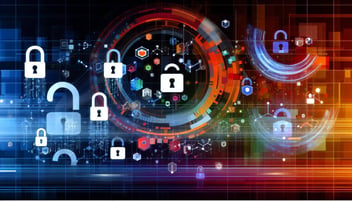What is Multifactor Authentication (MFA) and How Can It Enhance Your Security?
By Token | 10 minute read
In today’s increasingly digital landscape, securing online accounts and enterprise infrastructure has become paramount. Passwords, while still widely used, have proven insufficient to safeguard accounts from malicious actors. The evidence supporting this is compelling. Enterprises are witnessing an unprecedented surge in cyberattacks, resulting in substantial financial losses and heightened accountability for those who fall victim to data breaches.
The Role of Multifactor Authentication
Multifactor Authentication (MFA) emerges as a crucial solution, providing an additional layer of security by mandating the verification of user identity beyond a password. This blog post delves into the intricacies of MFA, elucidating its functionality and its pivotal role in bolstering online security. Furthermore, we will explore the limitations of current MFA implementations and envision the future trajectory of this technology.
Traditional Multifactor Authentication (Legacy MFA)
Traditional MFA, also known as legacy MFA, enhances security by requiring users to provide multiple forms of identity verification when accessing an account or service. This approach typically involves entering a username and password, a form of single-factor authentication, which is one of the most common authentication methods for user authentication. However, passwords have inherent vulnerabilities, susceptible to theft, guessing, or inadvertent sharing, rendering them a weak security measure.
In contrast, MFA mandates a second factor as additional security to substantiate user identity. This can manifest in various forms, such as passwords or PINs, temporary one-time passwords, physical device access verification, or biometric authentication. By employing MFA, organizations mitigate the risks associated with password-based security and fortify their online defenses. Solutions like the biometric authentication ring help establish a more robust security system, significantly enhancing the difficulty for unauthorized users or attackers to gain access to sensitive accounts. However, with each layer of authentication, the burden for authorized users who correctly access systems also increases.
Fundamental Principles of MFA, Functionality, and Common Forms
The most prevalent form of MFA entails the combination of a password with a secondary verification step, typically linked to the demonstration of a user’s access to a physical device.
For instance, after entering your password, a code is transmitted to your mobile phone, which you subsequently input to complete the login process. The mobile phone must have been previously established as your device, thereby granting assurance that the intended recipient possesses access to that mobile phone. Consequently, this approach significantly diminishes the likelihood of a successful breach.
Here’s how MFA typically operates:
- Knowledge Factor (something you know): A personal attribute that only the user possesses. This could be a PIN, password, or a security question that only the user knows.
- Possession Factor (something you have): A physical item that the user has control over. This could be a smartphone, computer, or even a hardware token. For instance, the service may send a one-time code to your phone or utilize an authenticator app to verify your identity.
- Inheritance Factor (something you are): A characteristic that is unique to each individual. This could include biometric data such as fingerprints, facial recognition, or voice verification.
These factors enhance security because they are distinctive to each individual and sharing or divulging them presents challenges. By employing at least two of these factors, MFA provides a stronger defense against unauthorized access.
Challenges of Traditional MFA
Despite the added layers of security provided by MFA, not all implementations are entirely foolproof. MFA requires multiple factors for authentication, yet certain MFA methods remain susceptible to specific types of phishing attacks, such as spear phishing. For instance, an attacker could manipulate a user into disclosing their authentication code by impersonating a reputable service or website. If an attacker gains access to both a user’s password and their secondary factor, such as a one-time code, they can still breach an account.
The level of effort and complexity required to execute such an attack is diminishing over time. What was once the exclusive domain of government threat actors or highly sophisticated cyber-attacking groups is now readily accessible to virtually anyone on the internet through open-source tools, illicit websites, or the dark web.
Another concern with conventional MFA methods pertains to the transmission and storage of sensitive information, particularly biometrics. If authentication data, such as biometric information used for verifying a user’s identity, is transmitted or stored centrally without adequate security measures, it can be compromised or misused—similar to passwords. Real-world examples of such breaches include the Office of Personal Management incident several years ago.
While biometrics offer convenience and entropy, securing them becomes a more significant responsibility for enterprises, as biometrics cannot be easily reset like passwords or one-time codes. To address these risks, contemporary MFA authentication methods frequently incorporate local biometric authentication, such as through a FIDO2 ring, which occurs on a specific hardware device and does not involve the transmission or remote storage of biometric templates. Additionally, advanced technologies are employed to diminish reliance on traditional methods, such as SMS-based text message codes. Furthermore, modern multifactor authentication must be phishing-resistant. This entails ensuring that modern MFA can withstand these increasingly prevalent attacks that aim to surreptitiously obtain users’ confidential information.
Enterprises invest a significant amount of money annually on compliance and user training, requiring employees to identify legitimate emails and websites from imposters. As complexity increases, discernment becomes costly and challenging, placing the burden on employees within enterprises. Modern Multifactor Authentication (MFA) aims to alleviate this burden by automating user verification and reducing the responsibility on individual users.
Key Terms to Understand MFA:
- Authentication: The process of verifying a user’s claimed identity.
- Multi-Factor Authentication (MFA): A method requiring users to provide two or more verification factors, such as a password and a physical device or biometric data.
- Biometric Authentication: Verification of a claimed identity based on unique physical traits, such as fingerprints or facial recognition.
- One-Time Password (OTP): A code or password received via a mobile app or hardware key valid only for a single login session or a short time frame.
- Relying Party (RP): The service or application requiring user verification, such as Google, Microsoft, Okta, or others.
Benefits of Token’s Next-Generation MFA
The most advanced forms of MFA today are hardware security tokens that are phishing-resistant, reducing the burden on users to discern the legitimacy of the relying party. Protocols like FIDO enable secure and simple authentication processes, eliminating the need for remote storage of secret keys. All secret credentials are generated on the user’s hardware security token, ensuring their protection and eliminating the need for users to determine the website’s legitimacy. However, deploying such devices at scale can be challenging. Therefore, next-generation MFA should combine the scalability and user-friendliness of authentication applications with the security provided by hardware security tokens.
With the Token MFA Ring enterprise users can achieve the best of both worlds. This hardware product offers the same security assurances as the FIDO protocol, including phishing resistance and decentralized credential management, while minimizing the user burden. Users simply need to touch their fingerprint to the fingerprint sensor on the device, verifying multiple factors of authentication in a single step. Furthermore, these devices are designed to seamlessly integrate with all the devices and platforms users encounter within an enterprise environment.
They integrate with all the major identity and access management (IAM) systems, SSO providers like Okta, Microsoft, and Google, and enable direct passwordless authentication for websites and services that support passwordless FIDO login.
Enterprise customers can be confident that the individuals using the Token smart ring are who they claim to be, as user verification occurs on the device, and biometrics remain securely stored within the product. Additionally, the private keys used for FIDO authentication are generated on the device and never leave the secure element. With Token’s next-generation solution, enterprise customers gain access to a software platform that facilitates inventory management and deployment of these hardware products, resembling the familiar software-as-a-service interfaces that enterprise IT and CISO admins have come to expect.
With Token Next-Generation MFA, enterprise customers can enjoy exceptionally high levels of assurance and security akin to hardware security tokens, while simultaneously benefiting from the scalability and user-friendliness of software-based solutions.
Furthermore, the Token smart ring offer field upgradability, allowing for future enhancements to the user experience, supported features, or security improvements without the need for enterprises to replace their entire fleet of hardware security keys, as they would with traditional solutions.
Is MFA the Future of Secure Authentication?
Cyberattacks are becoming much more sophisticated, meaning that organizations need stronger means of security. Old methods of verifying your identity, like receiving a code via text or using a token, aren't enough anymore. Scammers can bypass these with tricks like SIM card swapping or phishing emails that steal your information.
Token ring authentication overcomes today’s security challenges by storing biometric data directly on the ring, so private data isn’t available elsewhere. This translates to better safety and smoother logins—just tap your ring with your scanned finger and you're in. The Token Ring's smart use of biometrics and on-device storage is changing the game for extra-secure logins.
As hackers get smarter, defenses need to as well. Security-conscious organizations are adopting Next-Generation MFA – keeping their sensitive data secure today and into the future.
Request a demo today and see how Token’s Next-Generation MFA can secure your organization from phishing and ransomware attacks with ease and simplicity.
FAQ
Sign Up
Keep up to date with phishing and ransomware news.
Token will not sell, trade, lease, or rent your personal data to third parties.



